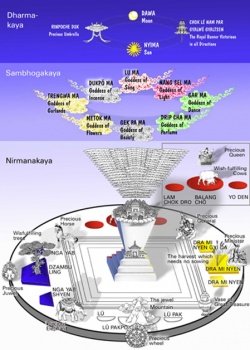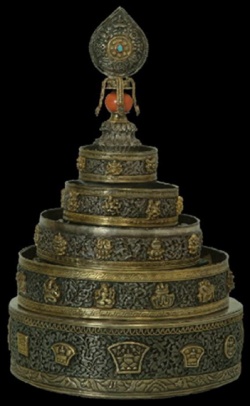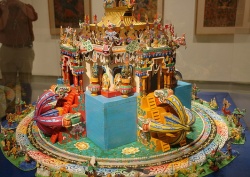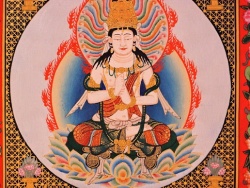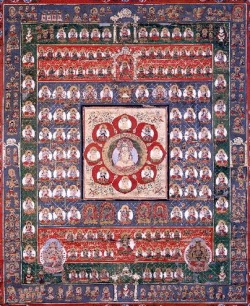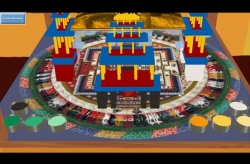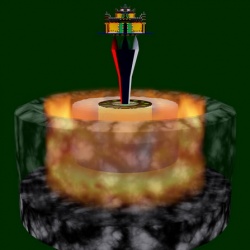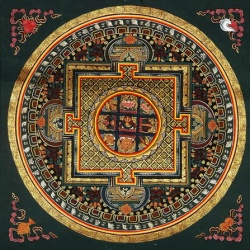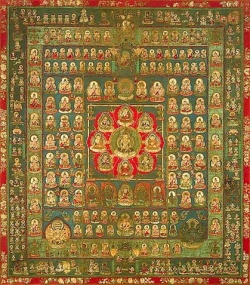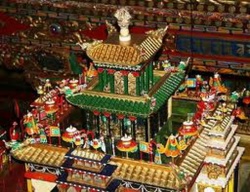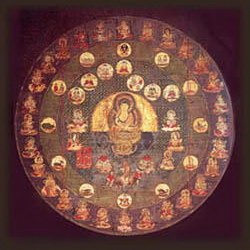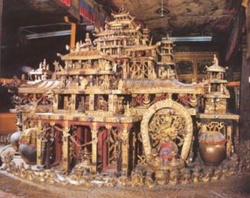Mandala offering by Lama zopa rinpoche
The mandala offering is a very powerful method for accumulating extensive merit and quickly realizing bodhicitta and emptiness. Just as great strength is needed to carry a heavy load, a great amount of merit is needed to lead all sentient beings to enlightenment, complete freedom from suffering. There’s nothing that can be offered with your hands that is more meritorious than offering mandalas. You do not have to offer all your wealth right now while offering mandala, you just have to mentally give away all of your wealth which
you are so much attach to. When your practice reach a very high level then you can actually give away those for others benefit or offer it to your guru and triple gem. So be happy to offer which is of great benefit and nothing to lose.
The Tibetan term for mandala is kyil.kor, which means “taking the essence.” The essence you take is the whole path from Guru devotion to Enlightenment. Guru devotion is a basic practice without which no realizations come. Thats why guru devotion comes first in the practice, which are states in lamrim( a stages of path to enlightenment) of kagyu, geluk, sakya and nyingma.
Lama zopa rinpoche states that,”Offering the mandala contains the practice of all six perfections. By cleaning and blessing the mandala base with liquid called drijang you practise the perfection of giving. Just like water bowl offering. Checking the grain for insects and looking after the base, keeping it clean, leads to the perfection of moral conduct. Just as a bikshu are not allowed to harm even
a most tiny insects. Removing insects from the grain without harming them leads to the perfection of patience. During checking for the insects it is time taking and sometimes people with less patience became bored of and even throw the mandala out of anger. Thinking of how fortunate you are to be able to practice dharma and making the offering with joy you cultivate joyous effort. By not forgetting the visualization you attain concentration. Just like during shamatha, one is not allowed to lose his/her object of visualization. By clearly visualizing the colors and objects in the mandala, and by meditating on its emptiness, wisdom is attained. Therefore offering mandalas helps you to quickly complete the two accumulations of the merits of method and wisdom as it contains all six perfections”.
So it is of great benefits which gives you a chance to practice all the six perfections which is the essence of buddhist practice. Without practicing these, you will not attain enlightenment even you have a bodhichitta mind.It also removes all the obstacles to ultimate happiness.
Lama Tsong Khapa offered a hundreds and thousands of mandalas and achieved all the realizations of the stages and paths. After offering all these mandalas his understanding of emptiness deepens and his practices were much superior than before. If you wish to gain realizations you should offer mandalas to your guru every day as his jewel-like body can bestow the sphere of great bliss in an instant. All realizations depend on your guru. Offering mandalas to him/her is like offering gifts to a king before requesting a favor of him. Achieving enlightenment in one lifetime depends on your relationship with your guru.
You can see your guru as buddha or far more than buddha because he is the one who shows you the path of enlightenment and guides you in every aspects of practice.We didn’t see buddhas in their real form because of our ignorance, but we see and hear our guru who had taken human form to shows the path to us. Which is very kind action so we must respect our gurus at any cost.
Lama Tsong Khapa was instructed by Manjushri to leave the monastery and go to a hermitage where he was to concentrate on bodhicitta, seeing his guru as Buddha, meditate on the path, purify and accumulate merit. Without working on all of these, even if you practice for a hundred years you won’t gain realizations. However, if you do, you will receive realizations within three years or even in a few months. The mere wish to make progress doesn’t make it happen. It’s necessary to create the causes, one of which is accumulating merit.
Lama zopa says that basically, offering the mandala involves mentally offering the entire universe: all the planets and worlds, all sense objects, and especially the objects to which there is much clinging such as your body, possessions and friends. All these are offered to the merit field. The essential technique of offering is to offer the best quality materials, in the greatest quantity and to have as clear a visualization as possible. In this way you can create extensive merit in just a short time.
Even if you’re a beggar, by making mandala offerings you will receive all the necessities for your practice in this and future lives. By visualizing and then offering whatever you need in the space above the mandala, you create the cause to receive it. Visualizing anything golden and offering it to the Buddhas frees you from disease, and offering the moon creates the cause for you to be reborn as a god or a holy being. Offering jewels, gold and enjoyments creates the cause to be reborn in the caste of kings.
If you don’t have good materials you can even use a stone for the mandala base (but first you should ask permission of the spirit landlord, otherwise it’s like stealing). Lama Tsong Khapa’s forearm was blue and bloody with scabs and callouses from making mandala offerings on a stone during his eight year retreat. This doesn’t mean that lamas don’t have money to buy gold and silver bases. Lama Tsong Khapa did this to emphasize the importance of pure morality. If you are abiding in pure moral conduct you aren’t allowed to touch precious metals with attachment. However, the more valuable the material you offer, the more merit you receive. The best is a gold or silver base, then copper or brass. The finest things to offer are piles of gold, silver, or jewels; next best are sea shells; rice or other grains are acceptable. As mandala offerings are of great consequence you should offer the finest materials you can afford. If you have enough money to provide yourself with the comforts of life but you use inferior materials for offering, the only result of your offering will be a decrease of merit.
But by visualizing the offerings as more precious and extensive, you create vast merits. For example, imagining that you’re offering a Mt Meru of silver, lapis lazuli, ruby and gold, even if there are no such materials on your base, you receive the merit of actually offering them. So in just a few seconds it’s possible to create the merit of having offered the entire universe. When you offer water bowls it’s good to visualize the water as nectar. The water appears as nectar to the devas, so of course it appears as nectar to the Buddhas — this is explained in Maha-Annuttara Yoga Tantra. It generates infinite bliss in the holy mind. So if you offer only water, you get the merit of offering water, but if it’s offered as nectar you gain much more merit because of the superior quality of that offering. If a person continually makes offerings of water bowls and mandalas, after a few years that person will have better materials to offer. The result is experienced in this life because any merit accumulated with the guru-buddha is very powerful. The same is true for good karma created with a bodhisattva or parents: the result will be experienced in this life.
Objects Offered In The Mandala , 37 types
1. Mt. Meru: First place a heap of grain in the center of the base to represent Mt. Meru, which has four faces, The eastern face is made of radiant, silvery crystal.The southern face is of bright blue lapis lazuli.The western face is of ruby.The northern face is of gold.Before doing this, hold the base of mandala with your left hand with some grains in your left hand. Dont do it empty handed.Then think of Mt.meru’s all qualities( search it in google)Then towards the four direction of mt meru. place each heap of grain for four world described below.
2. The Eastern World: it is white and semi-circular like a half-moon. The people who live there are tall and very beautiful with half-moon-shaped faces. They have subdued minds and limitless possessions. They always enjoy a high status and live for three hundred years. They eat rice and vegetables. They are a quiet, peaceful people who never fight, but they have no religion.
3. The Southern World (this is our world): it is blue and trapezoidal (similar to the canopy of an Indian rickshaw). The inhabitants’ faces are the same shape as their world, as is true of all the worlds. Here, many people have high realizations.
4. The Western World: it is red and circular. The people here have round faces, live for five hundred years and have infinite enjoyments.
5. The Northern World: it is yellow and square. The people here have square faces and beautiful bodies made of light. They live for a thousand years. The standard of life is god-like: there is no fighting, food grows in abundance; the moment one is born one receives everything one needs. Because there is very little suffering there is no desire for religion and the people are unaware of death. But seven days before they die, they hear a voice whispering, telling them where they will be reborn and what sufferings they will experience. Because they do not have much suffeiring it is hard to practice dharma.
6-13. Each world has two smaller, similarly-shaped and colored sub-worlds on either side of it. These are the next eight heaps of grain on the base. First put a heap to the left of the main world, then one to the right (i.e. for the eastern world, put the first heap in the south-east and the second in the north-east, then move on to the southern world.)
The next four objects are called the four “precious things.” They are the particular enjoyments of each of the four worlds; things that the inhabitants of each world enjoy the most. We should visualize them in the aspect of offerings, but think that in essence they are realizations of the dharma. They are to be visualized floating in the sky above their respective world.
14. The Precious Mountain (east): this is a huge mountain made of the seven precious gems: gold, silver, lapis, coral, diamonds, pearls and emeralds.
15. The Wish-Granting Tree (south): it is huge and made of the seven precious gems: its roots are gold, trunk is silver, branches are lapis lazuli, leaves are emeralds, with sapphire buds, pearl flowers and diamond fruit. Thinking of whatever you wish for and praying to the tree, your needs pour down from it like rain. This is by the power of the object. When its leaves rustle, they make the sound of dharma. The people of the southern world like fruit, so this tree is their particular enjoyment.
16. The Wish-Fulfilling Cow (west): this cow is also made of jewels: with diamond horns, sapphire hooves and a tail like the wish-granting tree. Its body is golden-orangish colored, healthy and very beautiful. Its excrement is gold. Whatever one desires springs forth from its pores. It also gives unceasing milk.
17. The Uncultivated Harvest (north): these are crops that grow unceasingly, without needing to be cultivated. Its fruit is perfect: skinless and clean, easy to pick (just falls off in one’s hand), beautiful and delicious, satisfying all desires.
(If using four rings, place the second ring at this point. If using three rings, the second ring is placed later.)
The next seven objects are the seven possessions of a Chakravartin (wheel-turning) or universal monarch; offering them creates the cause to become such a monarch. The qualities of these objects are explained in the Heruka Lama Chopa.
18. The Precious Wheel (east): this is a vehicle for the universal monarch, actualized by and propelled by his great stock of merit. It travels very fast – it can cover the four worlds and the god realms in a day – and can carry the monarch and his entire retinue to any part of the universe he wishes to go to.
Made of gold, with a thousand spokes, it’s very bright, like the sun. The wheel is symbolic, when offering it, dedicate: “By offering this precious wheel, may I and all sentient beings achieve complete control over dharma activities (like Guru Shakyamuni Buddha and His Holiness the Dalai Lama). By understanding the different levels and so on of sentient beings and teaching them accordingly, may I lead all of them to enlightenment.”
Guru Shakyamuni Buddha, by understanding different beings’ capabilities, intelligence, merit, etc., can show various methods without error, and not only through his speech but also in various manifestations. He possesses all realizations of the words and their meanings. So by offering the precious wheel we pray to be able to do the same. This is the benefit of offering this wheel.
19. The Precious Jewel (south): this is an eight-sided wish-fulfilling jewel made of lapis lazuli. It is as bright as the sun, can make night like day-time, and emits light rays of five colors that can be seen for thousands of miles. These rays bring all success and whatever is needed by sentient beings. When we’re tormented by heat they make us feel cool; when it’s cold they provide warmth. They bring all happiness and prevent illness and untimely death to all those within their range. They also fulfill whatever dharma wishes sentient beings have.
Dedicate: “By offering this precious jewel, may all sentient beings have their dharma wishes fulfilled perfectly.”
20. The Precious Queen (west): she is extremely beautiful, charming, has a camphor-scented body and sweet-smelling utpala flowered breath. Perfectly dressed, she has a calm, subdued mind and gives good vibrations. She is free of the five faults of women: greed or miserliness with men and other objects, jealousy, anger and pride; and possesses the eight qualities of a perfect lady: harmonious mind, bearing only sons, of noble birth, of high caste, free of jealousy towards other women, does not gossip or hold wrong views, and remains unaffected by objects of the senses. She bestows bliss and freedom from hunger and thirst on any being who touches her. Her mind is endowed with love and compassion; she grants all success and guides all beings from physical and mental suffering.
Dedicate: “By offering this precious queen, may all sentient beings enjoy the non-contaminated, non-deluded great bliss of aryas.”
21. The Precious Minister (north): he has renounced all non-dharma actions, so all his projects are dharma-related and for the benefit of others. He is never treacherous or harmful, but always acts with love. He never gets upset about or tired of working for others. He spontaneously carries out the wishes of the universal monarch without having to be asked (he is able to read the monarch’s mind). He is extremely wise and skillful in all situations and in directing the activities of the entourage and the army.
Dedicate: “By offering this precious minister may all sentient beings fulfill exactly all the wishes of the Buddhas.”
22. The Precious Elephant (south-east): he is as large and as white as a snow mountain and as strong as a thousand ordinary elephants. He is so wise, skillful and alert that he doesn’t need to be led by a rope; a fine thread is enough. He is decorated like a ceremonial elephant. He has a large penis, and his trunk, tail and testicles touch the ground. He carries the universal monarch wherever he wants to go without needing to be ordered — he can read his master’s mind. He can travel around the universe three times in a day, without shaking or disturbing the rider’s body. He is peaceful, never violent or harmful to others; perfectly obedient, incredibly wise and able to conquer all opposing forces.
Dedicate: “By offering this precious elephant may all sentient beings ride the supreme great vehicle to enlightenment.”
23. The Precious And Excellent Horse (south-west): is white, of perfect shape, size and color, is decorated with the jewelled crown of the devas, a jewelled saddle and various jewelled ornaments. He can travel around the universe three times in one day, and never gets tired or sick. He is very wise and subdued and can be led by a thread; a bridle is not necessary. He is magnificent-looking, and protects his rider from harm.
Dedicate: “By offering this precious, excellent horse, may all sentient beings attain mundane and supramundane psychic powers.” (Offering the precious horse creates the cause to achieve clairvoyance.)
24. The Precious General (north-west): he never harms others as he has totally abandoned all non-dharma actions. However he can never be defeated in battle. He intuitively knows the wishes of his ruler, and never tires in his service. He leads large armies of horses, elephants, chariots and foot soldiers. In times of struggle and hardship visualizing the precious general prevents you from being harmed by others (the would-be harmers are subdued) and protects you from poverty.
Dedicate: “By offering the precious general may all sentient beings become holders of the entire collection of teachings.”
According to Lama Tsong Khapa, the precious householder is offered at this time, instead of the precious general, who is included with the precious minister. The precious householder has many possessions and jewels; all sentient beings are pleased to see him.
25. The Great Treasure Vase (north-east): it is made of gold and decorated with jewels. It has a flat base, large belly and long neck, like a Greek urn. The neck is decorated with cloth from the deva realms, and the vase has a beautiful tree as a stopper. The vase contains various treasures and grants all wishes.
(If using four rings, place the third one at this point. If using three rings, place the second.)
26. The Goddess Of Beauty (east): she is white, she stands in an S-shaped dancing posture with hands on her hips, holding a vajra in each hand. She exhibits her beauty through dancing and moving her body.
27. The Goddess Of Garlands (south): she is yellow-colored and very beautiful. She holds a rosary made of precious vajras with both hands at her breasts; with this she grants initiations to whomever comes before her.
28. The Goddess Of Song (west): she is pink-colored; she plays a lute and sings, offering the music to all beings.
29. The Goddess Of Dance (north): she is multi-colored: her face and feet are white, neck and breasts are pink, hands and hips are blue and her thighs are light yellow. She holds a vajra in each hand, with her right hand on her head and left hand on her left hip.
30. The Goddess Of Flowers (south-east): she is bright yellow; in her left hand she holds a vase containing a vajra and flowers. She scatters the flowers in the air with her right hand.
31. The Goddess Of Incense (south-west): she is white; in her right hand she holds an incense burner at the level of her shoulder. The incense totally satisfies whoever it’s offered to. Her left hand is in the threatening gesture at her left shoulder.
32. The Goddess Of Light (north-west): she is pink and holds a beautiful lamp on her left shoulder with her right hand held over her head. Her left hand is at her heart.
33. The Goddess Of Perfume (north-east): she is rainbow-colored. In her left hand at her heart she holds a conch shell containing a vajra and beautifully scented sandal water. With her right hand she sprinkles this perfume in all directions.
These eight goddesses, visualized in space above the first level of Mt. Meru , are the emanations of your own transcendental wisdom of non-dual bliss and emptiness. They should be visualized as young and very beautiful. They have slender waists, enchanting faces with fine blue eyes and red lips. Their bodies are fragrant; they have soft, smooth skin which, when touched energizes great bliss. Any sounds they make are lovely to hear. Visualizing the goddesses as exquisitely beautiful in all respects is for the purpose of transforming desire into the path. Imagine that all space is filled with these goddesses.
(If using four rings, place the fourth at this point. If using three, place the third.)
34. The Sun (south): it’s in the southern sky above the level of Mt. Meru. It’s like a gigantic magnifying glass dispelling darkness (the darkness of sentient beings’ gross and subtle delusions); like a clear lens through which hot rays are focussed, and it emits brilliant rays of light. Its shape is that of a disc, with a golden fence around its edge. At its centre, stairs lead to a palace in which the children of the gods are dancing and singing.
Think about the function of the sun; for instance, how it causes crops to ripen.
The sun signifies all wisdoms, all paths: Hinayana, Mahayana and Vajrayana. It signifies the clear light, which results in the dharmakaya. The sun is absolute bodhicitta; it dispels the darkness of ignorance grasping at true existence, the root of samsara.
35. The Moon (north): the moon, in the northern sky, is the same size as the sun and is equal to the sun in brightness. Usually, the sun’s light obscures the moon but in the mandala the light of both pervade the world. The moon is also disc-shaped, with a fence around its edge and a palace at its centre where the children of the gods are singing and dancing. The moon causes samsara to cease; its two edges are the two extremes which it eliminates. The light of the moon has the power to dispel sentient beings’ gross obscurations.
The moon symbolizes method, the methods of the three vehicles; also conventional bodhicitta, whose root is compassion. Its light extinguishes the darkness of the self-cherishing attitude, so that we naturally come to cherish others. The light also prevents us from falling into the blissful state of self-liberation.
The moon and the sun are visualized together because method and wisdom, bodhicitta and emptiness, should be practised together, simultaneously. From the tantric viewpoint the sun represents the clear light of wisdom and the moon represents the illusory body. Visualize that the light of the sun and moon dispels the darkness of the obscurations and ignorance of all sentient beings. By visualizing like this you create the cause to achieve the entire path, both the method and wisdom aspects, that result in attaining the Rupakaya and Dharmakaya. The sun and moon are also offerings of light.
36. The Precious Parasol (east) : its handle is of lapis lazuli encrusted with jewels and gold. Its thousand spokes are of gold, and it is crowned with an eight-sided sapphire. The canopy is white and has a fringe hanging all around; the ends of the fringe are richly decorated with various jewels, some of which are like magnifying glasses and emit powerful light. There are also strands of pearls hanging from the edge; from the jewels and pearls comes a flow of nectar that eliminates the true sufferings and true causes of suffering of all sentient beings. There are small glass vases hanging from the fringe from which nectar pours as an offering to the Buddhas. This nectar also quenches the thirst and alleviates the suffering of those beings who suffer from thirst. There are also small bells making very sweet dharma sounds in praise of the Buddha and teaching sentient beings according to the level.
This parasol is similar to the one that the naga King Maitri offered to Lord Buddha. Its essence is all the qualities of the cessations, the abandonment of the two obscurations. The parasol can provide extensive protection from suffering and offering it creates the cause for oneself to become an object of refuge, able to save sentient beings from the heat of samsara.
37. The Banner Of Victory Throughout All Directions (west): it has a jewelled shaft with three pieces of cloth hanging from it. There are innumerable small bells hanging from the banner making pleasant tinkling sounds. The banner is illustrated with different symbols, such as an eight-legged lion and a special kind of fish. Its top is crowned with a half-moon and an eight-sided sapphire.
The essence of the banner is all qualities of all realizations. It symbolizes total victory; by offering it we create the cause to be victorious over the four maras. We also create the cause to be able to benefit others perfectly by leading them according to their level, and to liberate them from the fears and sufferings of samsara. It brings about the auspicious conditions for us to realize the dharma and thus become a holder of the banner of the teachings, like Vajradhara.
In times of trouble banners were placed in the roofs of monasteries to overcome negative forces. By putting the banner in the front of the mandala, we create the cause to have perfect listening, reflecting and meditation, and to become a holder of all dharma teachings.
Now place three heaps in the center, symbolizing the realizations of the body, speech and mind of the merit field; by offering these we create the cause to be able to attain them. Then place the mandala top. With a small amount of grain in both hands, hold up the mandala. While offering mandala from beggining, your left hand should not be empty. Take some grains and hold the base with left hand.
“… u.su lha.dang mi …” — “at the center are all possessions precious to gods and humans …” Visualize clouds of offerings floating in space above the center of the mandala. These include: your body, wealth and all your merits of the three times as well as all the various enjoyments of gods and humans.
As you recite the prayer mentally offer all that brings pleasure to the five senses. Imagine that you are offering everything, not leaving anything out: all the possessions of gods and humans as well as all the wonderful things that exist throughout the ten directions and are not possessed by anyone.
Hold the mandala at your heart and without attachment to the offerings, offer them with devotion. At the end of the prayer imagine that the mandala dissolves into light and absorbs into the heart of the guru-deity. Think that the guru experiences incredible bliss. Then tip the mandala base to dismantle the mandala: towards you if the offering was made in order to receive realizations, and away from you if the offering was made to the merit field. As you do this, light comes from the guru and enters your body, purifying all hindrances and negative karma of body, speech and mind. Then a replica of the guru dissolves into you. Think that you have become one, completely unified, with the guru and have received all his realizations.
